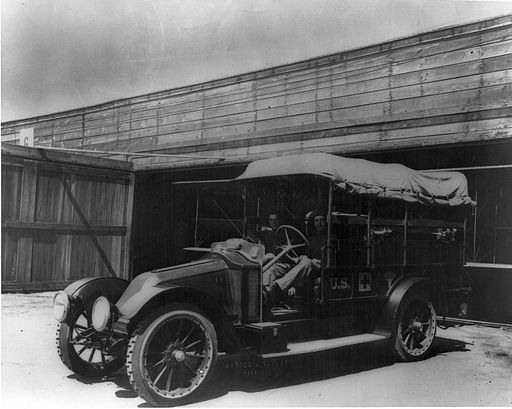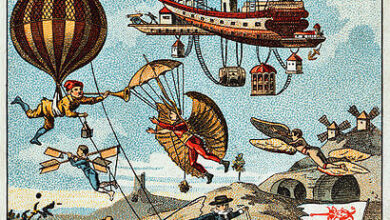
At the End of the Ambulance Run by Ernest Hemingway
At the End of the Ambulance Run was a newspaper article Hemingway wrote for the Kansas City Star, published April 20, 1918, retrieved from Wikisource.
An illustration for the story At the End of the Ambulance Run by the author Ernest Hemingway
Renault ambulance on Rockwell Field, 1918
The night ambulance attendants shuffled down the long, dark corridors at the General Hospital with an inert burden on the stretcher. They turned in at the receiving ward and lifted the unconscious man to the operating table. His hands were calloused and he was unkempt and ragged, a victim of a street brawl near the city market. No one knew who he was, but a receipt, bearing the name of George Anderson, for $10 paid on a home out in a little Nebraska town served to identify him.
The surgeon opened the swollen eyelids. The eyes were turned to the left. “A fracture on the left side of the skull,” he said to the attendants who stood about the table. “Well, George, you’re not going to finish paying for that home of yours.”
“George” merely lifted a hand as though groping for something. Attendants hurriedly caught hold of him to keep him from rolling from the table. But he scratched his face in a tired, resigned way that seemed almost ridiculous, and placed his hand again at his side. Four hours later he died.
It was merely one of the many cases that come to the city dispensary from night to night — and from day to day for that matter; but the night shift, perhaps, has a wider range of the life and death tragedy — and even comedy, of the city. When “George” comes in on the soiled, bloody stretcher and the rags are stripped off and his naked, broken body lies on the white table in the glare of the surgeon’s light, and he dangles on a little thread of life, while the physicians struggle grimly, it is all in the night’s work, whether the thread snaps or whether it holds so that George can fight on and work and play.
Here comes another case. This time a small man limps in, supported by an ambulance man and a big policeman in uniform. “Yes, sir, we got a real robber this time — a real one — just look at him!” the big officer smiled. “He tried to hold up a drug store, and the clerks slipped one over on him. It was a–“
“Yes, but they was three of ’em, an’ they was shootin’ all at once,” the prisoner explained. Since there was no use in attempting to deny the attempted robbery, he felt justified in offering an alibi for his frustrated prowess. “It looks like I oughtta got one of ’em, but then, maybe, I’ll do better next time.
“Say, you’d better hurry up and get these clothes off of me, before they get all bloody. I don’t want ’em spoiled.” He was thoroughly defeated and dejected, and the red handkerchief he used for a mask still hung from his neck.
He rolled a cigarette, and as the attendants removed his clothes, a ball of lead rattled to the floor. “Whee! It went clear through, didn’t it? Say, I’ll be out before long, won’t I, doc?”
“Yes — out of the hospital,” the physician replied significantly.
Out on Twenty-seventh street a drug clerk — the one of the three who used the .38 — has a .38 bullet dangling from his watch chain.
- * One night they brought in a negro who had been cut with a razor. It is not a mere joke about negroes using the razor — they really do it. The lower end of the man’s heart had been cut away and there was not much hope for him.
Surgeons informed his relatives of the one chance that remained, and it was a very slim one. They took some stitches in his heart and the next day he had improved sufficiently to be seen by a police sergeant.
“It was just a friend of mine, boss,” the negro replied weakly to questioning. The sergeant threatened and cajoled, but the negro would not tell who cut him. “Well, just stay there and die, then,” the officer turned away exasperated.
But the negro did not die. He was out in a few weeks, and the police finally learned who his assailant was. He was found dead — his vitals opened by a razor.
“It’s razor wounds in the African belt and slugging in the wet block. In Little Italy they prefer the sawed-off shotgun. We can almost tell what part of the city a man is from just by seeing how they did him up,” one of the hospital attendants commented.
- * But it is not all violence and sudden death that comes to the attention of the emergency physicians. They attend the injuries and ills of charity patients. Here is a laborer who burned his foot one morning when he used too much kerosene in building the fire, and over there is a small boy brought in by his mother, who explains there is something the matter with his nose. An instrument is inserted into the nostril of the squirming youngster and is drawn forth. A grain of corn, just sprouted, dangles at the end of the steel.
One day an aged printer, his hand swollen from blood poisoning, came in. Lead from the type metal had entered a small scratch. The surgeon told him they would have to amputate his left thumb.
“Why, doc? You don’t mean it do you? Why, that’d be worsen sawing the periscope off of a submarine! I’ve just gotta have that thumb. I’m an old-time swift. I could set my six galleys a day in my time — that was before the linotypes came in. Even now, they need my business, for some of the finest work is done by hand.
And you go and take that finger away from me and — well, it’d mighty interesting to know how I’d ever hold a `stick’ in my hand again. Why, doc!–“
With face drawn, and head bowed, he limped out the doorway. The French artist who vowed to commit suicide if he lost his right hand in battle, might have understood the struggle the old man had alone in the darkness. Later that night the printer returned. He was very drunk.
“Just take the damn works, doc, take the whole damn works,” he wept.
- * At one time a man from out in Kansas, a fairly likable and respectable sort of man to look at him, went on a little debauch when he came to Kansas City. It was just a little incident that the folks in the home town would never learn about. The ambulance brought him from a wine room, dead from a stroke of heart disease. At another time (it happens quite often) a young girl took poison. The physicians who saved her life seldom speak of the case. If she had died her story might have been told — but she has to live.
And so the work goes on. For one man it means a clean bed and prescriptions with whiskey in it, possibly, and for another, it is a place in the potters’ field. The skill of the surgeon is exercised just the same, no matter what the cause of the injury or the deserts of the patient.
- * The telephone bell is ringing again. “Yes, this the receiving ward,” says the desk attendant. “No. 4 Police Station, you say? A shooting scrape? All right they’ll be right over.” And the big car speeds down the Cherry Street hill, the headlights boring a yellow funnel into the darkness.




